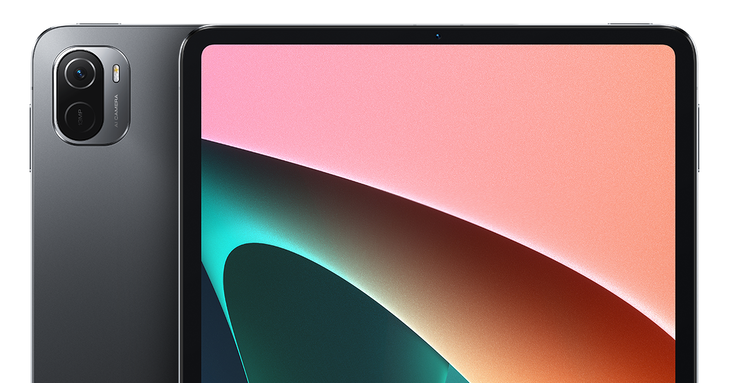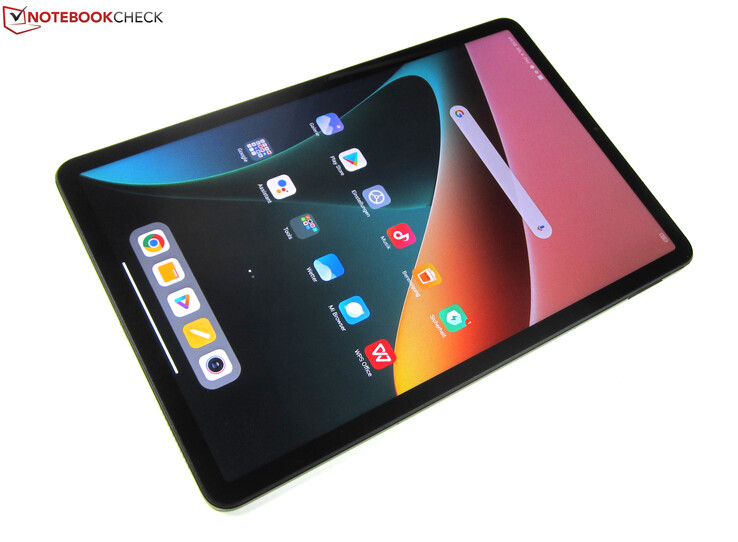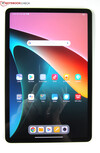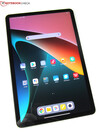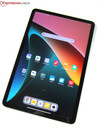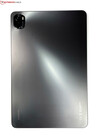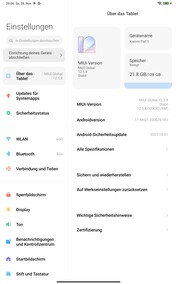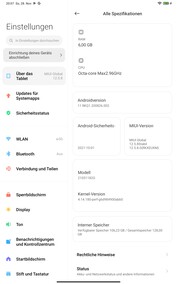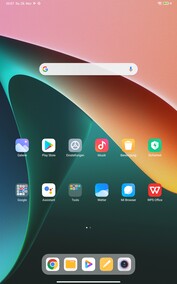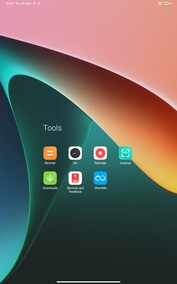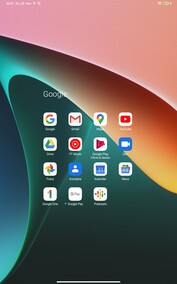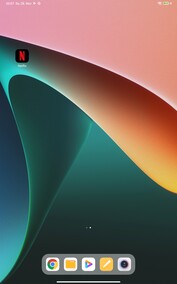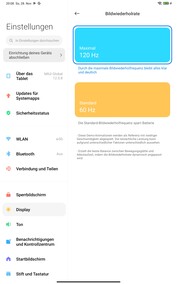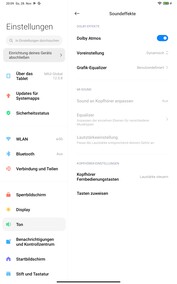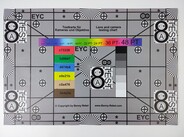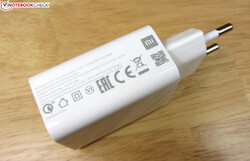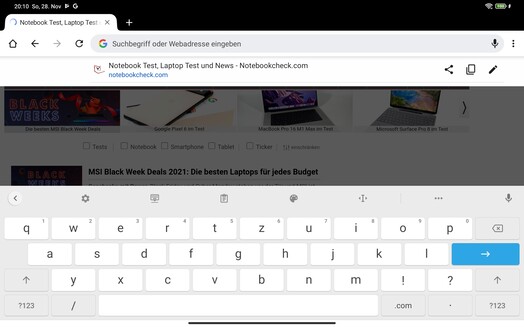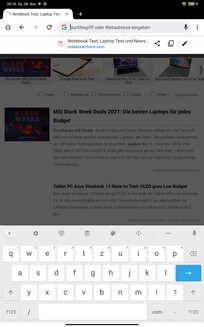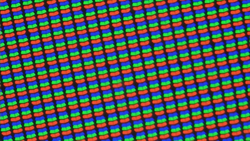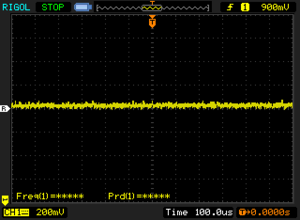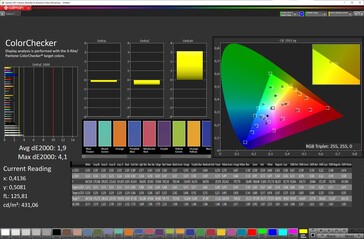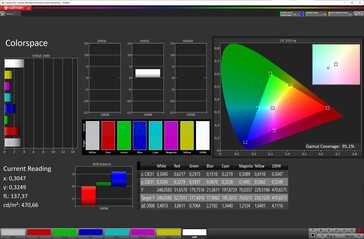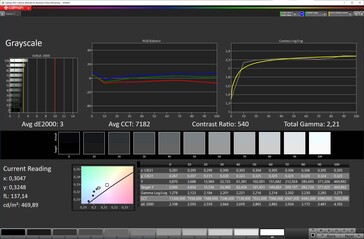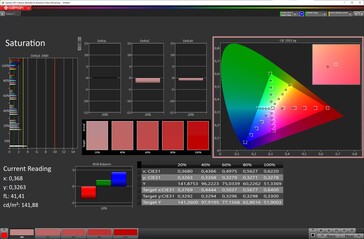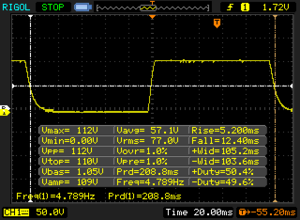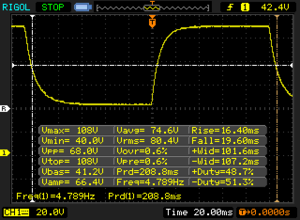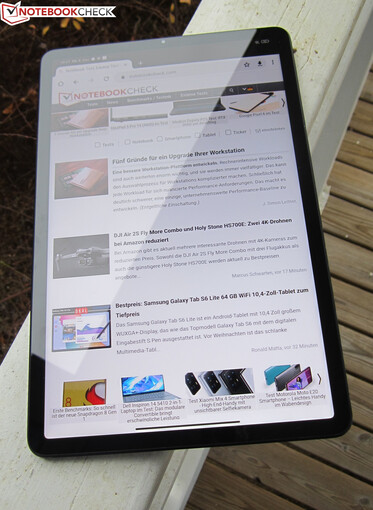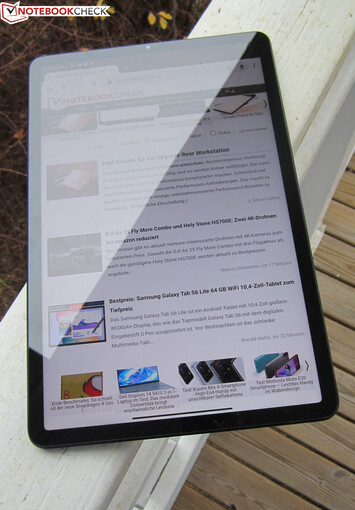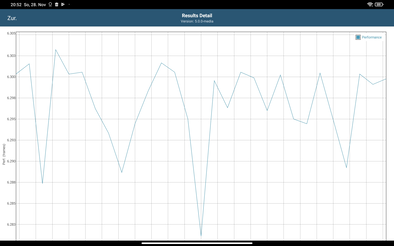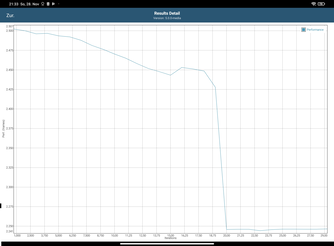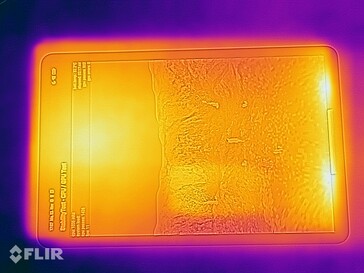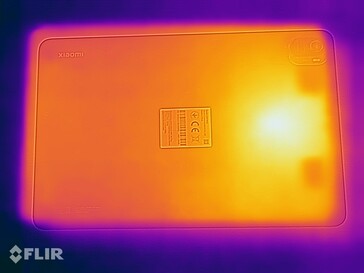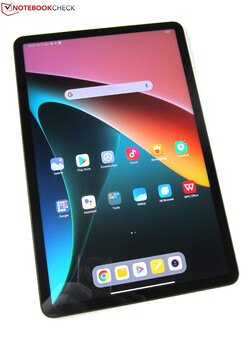Xiaomi Pad 5 Tablet review - Android-Alternative to the cheapest iPad
Cheap and inexpensive or expensive and very well equipped - because many tablets range between these extremes, there is not much choice when it comes to mid-range models. However, this is now increased with the Xiaomi Pad 5, which is available for 400 Euros (~$450).
The 11-inch Xiaomi Pad 5 is equipped with the fast Snapdragon 860 and is supported by 6 GB of RAM and 128 GB of storage. Other features include a nominally 500 cd/m² bright IPS display with a resolution of 2560 x 1600 pixels and a frame rate of 120 Hz. In addition, there are 4 speakers and an 8720 mAh battery battery.
We will find out how the Pad 5 compares with the competition in our review.
Possible competitors in comparison
Rating | Date | Model | Weight | Height | Size | Resolution | Price |
|---|---|---|---|---|---|---|---|
| 87.6 % v7 (old) | 12 / 2021 | Xiaomi Pad 5 SD 860, Adreno 640 | 511 g | 6.85 mm | 11.00" | 2560x1600 | |
| 88.5 % v7 (old) | 10 / 2021 | Apple iPad 2021 A13 Bionic, A13 Bionic GPU | 487 g | 7.5 mm | 10.20" | 2160x1620 | |
| 88.4 % v7 (old) | 09 / 2021 | Huawei MatePad 11 2021 SD 865, Adreno 650 | 485 g | 7.25 mm | 10.95" | 2560x1600 | |
| 83.4 % v7 (old) | 10 / 2021 | Lenovo Yoga Tab 11 Helio G90T, Mali-G76 MP4 | 655 g | 7.9 mm | 11.00" | 2000x1200 | |
| 83.1 % v7 (old) | 06 / 2020 | Samsung Galaxy Tab S6 Lite Exynos 9611, Mali-G72 MP3 | 467 g | 7 mm | 10.40" | 2000x1200 | |
| 88.7 % v7 (old) | 11 / 2021 | Xiaomi Pad 5 Pro SD 870, Adreno 650 | 515 g | 6.85 mm | 11.00" | 2560x1600 |
Case - Design model Apple iPad Air
In terms of price, the Xiaomi Pad 5 is close to the Apple iPad 2021, but its design is based on much more expensive tablets like the Apple iPad Air 4. However, with a weight of 511 grams (~1.1 pounds), it is a bit heavier than the Apple competitor and with just under 7 millimeters (~0.28 inches), it is not quite as thin.
The Xiaomi Pad 5, which is available in Pearl White and Cosmic Gray, has the same casing as its sister model Xiaomi Pad 5 Pro. Plus points are the sturdy aluminum frame and a matte back cover with a silky surface finish, which makes it look and feel high-end. The volume rocker and the power button, which unlike the Pad 5 Pro does not have a fingerprint sensor, are firmly attached to the chassis and have a crisp pressure point. There is a magnetic dock for the optional keyboard cover on the bottom.
The same points as in the Xiaomi Pad 5 Pro are also on the minus list for the chassis. The Pad 5 lacks Gorilla Glass as panel protection as well as an IP rating, and the back is only made of plastic.
Equipment - Only available as WiFi version
Xiaomi only offers the Pad 5 in one configuration: with 6 GB LPDDR4X RAM and 128 GB UFS 3.1 storage, which unfortunately cannot be expanded due to the lack of a microSD slot. Because the Pad 5, in contrast to the Pad 5 Pro, is only available as a Wi-Fi version, it also lacks a GPS module.
The USB-C port of the Pad 5 runs at USB 2.0 speed and supports connecting peripherals like a keyboard or mouse via USB OTG. Due to the lack of a 3.5 mm jack, the USB-C port also replaces the audio jack, but Xiaomi does not include a corresponding adapter with its tablet. The tablet supports DRM Widevine L1 and can thus play back streams in HD quality.
The Pad 5 is the little brother of the identically built Pad 5 Pro. The Pro model comes with up to 8 GB of RAM and 256 GB of storage, offers optional 5G cellular and uses the Snapdragon 870, an even faster SoC. There are also 8 speakers instead of 4, a fingerprint sensor and charging with 67 watts. The Pad 5 is limited to 33 watts.
Software - Android 11 and MIUI 12.5 for the Pad 5
The Pad 5 runs Android 11, which Xiaomi has overlaid with its in-house user interface MIUI 12.5. At the time of testing (mid-December), the Android security updates are up to date from October 1 and thus still fairly current.
About 106 GB of the 128 GB storage are free in factory fresh or reset state. Xiaomi almost completely omits third-party tools from its tablet. Only Netflix and WPS Office are installed, but they can be uninstalled easily.
Communication and GNSS - WiFi 5 and Bluetooth 5.0, but no GPS
The communication modules of the Xiaomi Pad 5 are quickly listed, because they are limited to Bluetooth 5.0 and WiFi 5 aka WLAN 802.11ac. The tablet does not support NFC. A cellular and GPS module are also not part of its repertoire.
The Pad 5 provides good transfer rates in WLAN, but they sometimes fluctuate noticeably in the receiving direction. When connected to our reference router, the Netgear Nighthawk AX12, it can narrowly beat the Apple iPad 2021 in terms of transmission and reception performance, but it cannot surpass a mid-range position among the comparison devices. The Xiaomi Pad 5 Pro is significantly faster.
Cameras - Good for video chats
Cameras usually play a subordinate role in tablets because they are rarely used for taking pictures, unlike smartphones. The camera module of the Xiaomi Pad 5 is quickly covered in the technical specifications: The 13 MP main camera records videos with up to 4K at 30 fps, the selfie camera has a resolution of 8 MP and videos in a maximum of 1080p at 30 fps - there is no more information. The same camera setup can also be found on the Xiaomi Pad 5 Pro.
The camera module of the Pad 5 does a better job than the scanty technical specs would lead us to believe or fear. However, the camera settings only offer minimum options. There are only a few picture modes and a Pro mode for manually adjusting the picture parameters is also missing. The camera software offers standards like HDR, flash, timer functions and an AI mode for automatic image optimization.
The selfie camera achieves a solid picture quality and also cuts a good figure in video chats. Users who want to take pictures with the main camera will not be disappointed with the Pad 5 either, as long as they do not expect more than good snapshots. The tablet takes quite detailed and vivid pictures in daylight via its 13 MP sensor, but they are sometimes a bit off track in terms of color tones, which are usually a bit too vivid. Zoom shots are okay as long as you do not enlarge the pictures too much. The camera visibly runs out of steam in low-light conditions, because the subjects then only appear blurry.
Image comparison
Choose a scene and navigate within the first image. One click changes the position on touchscreens. One click on the zoomed-in image opens the original in a new window. The first image shows the scaled photograph of the test device.
Daylight scene 1Daylight scene 25x ZoomLow lightWe take another close look at the main camera under controlled lighting conditions. In ideal lighting conditions, it hits bright and dark gray tones pretty accurately, but lacks precision in dark green and blue tones. Under low-light conditions (lower color chart at 1 lux), the displayed colors have nothing in common with the original, with the exception of dark gray tones, and you cannot see anything of the test chart.
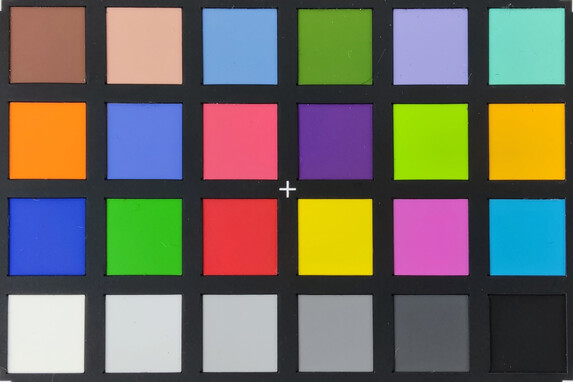

Accessories and warranty - Only one 22.5 watt power supply included
Xiaomi includes a 22.5-watt power supply, a USB cable (Type C to A), a quick start guide and a booklet with warranty information with the EU version of the pad. A 33-watt power supply is only available in the global version.
Optionally, you can purchase the stylus pen Xiaomi Smart Pen (100 Euro/~$112). However, there was no sign of the magnetically docking keyboard case at the time of testing.
The Pad 5 comes with a 12-month warranty.
Input devices & operation - Very smooth due to the 120 Hz screen
Thanks to its fast eight-core SoC, 6 GB of RAM and its 120 Hz display, the Xiaomi Pad 5 can be operated very smoothly. Unlike the Xiaomi Pad 5 Pro, the Pad 5 does not have a fingerprint sensor in the power button, leaving facial recognition as the only biometric recognition method. It does not work in the dark due to the lack of an IR sensor, but it scores with a high recognition rate even in low residual light and/or low display illumination.
Display - Good IPS panel without PWM
The IPS display of the Pad 5 has a resolution of 2560 x 1600 pixels and is well suited for sensitive users due to the lack of PWM flickering. The refresh rate can be set to 60 or 120 Hz. HDR10 and Dolby Vision are supported, but they cannot be displayed attractively due to the panel's brightness.
With an average of 472.7 cd/m² and a maximum of 497 cd/m², the Pad 5 pretty much meets the manufacturer's specification of 500 cd/m² in a pure white background. In the APL50 measurement, where bright and dark image areas are evenly distributed, the maximum luminance is 470 cd/m². Without the brightness sensor, the tablet manages up to 490 cd/m². The lowest brightness level is 2.43 cd/m².
| |||||||||||||||||||||||||
Brightness Distribution: 91 %
Center on Battery: 491 cd/m²
Contrast: 564:1 (Black: 0.87 cd/m²)
ΔE ColorChecker Calman: 1.9 | ∀{0.5-29.43 Ø4.78}
ΔE Greyscale Calman: 3 | ∀{0.09-98 Ø5}
95.1% sRGB (Calman 2D)
Gamma: 2.21
CCT: 7182 K
| Xiaomi Pad 5 IPS, 2560x1600, 11" | Apple iPad 2021 IPS, 2160x1620, 10.2" | Huawei MatePad 11 2021 IPS, 2560x1600, 11" | Lenovo Yoga Tab 11 IPS LCD, 2000x1200, 11" | Samsung Galaxy Tab S6 Lite TFT, 2000x1200, 10.4" | Xiaomi Pad 5 Pro IPS, 2560x1600, 11" | |
|---|---|---|---|---|---|---|
| Screen | 21% | -27% | -15% | -20% | 30% | |
| Brightness middle (cd/m²) | 491 | 507 3% | 550 12% | 380 -23% | 503 2% | 497 1% |
| Brightness (cd/m²) | 473 | 491 4% | 515 9% | 376 -21% | 477 1% | 475 0% |
| Brightness Distribution (%) | 91 | 90 -1% | 90 -1% | 89 -2% | 91 0% | 89 -2% |
| Black Level * (cd/m²) | 0.87 | 0.5 43% | 0.96 -10% | 0.24 72% | 0.29 67% | 0.42 52% |
| Contrast (:1) | 564 | 1014 80% | 573 2% | 1583 181% | 1734 207% | 1183 110% |
| Colorchecker dE 2000 * | 1.9 | 1.7 11% | 3.3 -74% | 4.61 -143% | 4.4 -132% | 1.4 26% |
| Colorchecker dE 2000 max. * | 4.1 | 3.9 5% | 7.9 -93% | 8.77 -114% | 10.4 -154% | 3 27% |
| Greyscale dE 2000 * | 3 | 2.4 20% | 4.9 -63% | 5.1 -70% | 7.5 -150% | 2.3 23% |
| Gamma | 2.21 100% | 2.25 98% | 2.24 98% | 2.248 98% | 2.19 100% | 2.25 98% |
| CCT | 7182 91% | 6923 94% | 7288 89% | 7966 82% | 7700 84% | 6744 96% |
* ... smaller is better
Screen Flickering / PWM (Pulse-Width Modulation)
| Screen flickering / PWM not detected | |||
In comparison: 53 % of all tested devices do not use PWM to dim the display. If PWM was detected, an average of 8108 (minimum: 5 - maximum: 343500) Hz was measured. | |||
In the display settings, you can choose from the 3 color schemes "Vivid", "Saturated" and "Standard". The colors can also be adjusted to the ambient light ("Adaptive Colors") and the color temperature can be set via color wheel or presets. The best picture quality is achieved when the tablet is set to the "Standard" picture mode and the other settings are simply ignored. In this case, the Pad 5 does not deliver a masterpiece with Delta E values of maximum 3, a color temperature of 7182 K and a gamma of 2.2, but it achieves a quite neutral display.
Display Response Times
| ↔ Response Time Black to White | ||
|---|---|---|
| 17.6 ms ... rise ↗ and fall ↘ combined | ↗ 5.2 ms rise | |
| ↘ 12.4 ms fall | ||
| The screen shows good response rates in our tests, but may be too slow for competitive gamers. In comparison, all tested devices range from 0.1 (minimum) to 240 (maximum) ms. » 38 % of all devices are better. This means that the measured response time is better than the average of all tested devices (20.2 ms). | ||
| ↔ Response Time 50% Grey to 80% Grey | ||
| 36 ms ... rise ↗ and fall ↘ combined | ↗ 16.4 ms rise | |
| ↘ 19.6 ms fall | ||
| The screen shows slow response rates in our tests and will be unsatisfactory for gamers. In comparison, all tested devices range from 0.165 (minimum) to 636 (maximum) ms. » 49 % of all devices are better. This means that the measured response time is worse than the average of all tested devices (31.6 ms). | ||
The tablet does well outdoors as long as direct sunlight is avoided. There are no restrictions at all in terms of viewing angle stability. Contents remain perfectly visible and do not change their colors even when viewed from very flat side views.
Performance - Plenty of power for everyday use
The eight-core SoC Snapdragon 860 with its integrated graphics chip Adreno 640 together with its 6 GB LPDDR4X RAM and 128 GB UFS 3.1 storage gives the Xiaomi Pad 5 a system performance that is easily sufficient for everyday tasks.
As expected, the Xiaomi tablet cannot compete in the benchmarks with its sister model the Pad 5 Pro, which is equipped with the faster SoC. From the Android camp, it is outperformed by the Huawei MatePad 11 2021, the closest in terms of performance. The Apple iPad 2021 is sometimes very close to the Pad 5 and can even beat it in GFXBench. Nevertheless, the Apple rival is almost always a bit ahead and does not give any Android tablets a chance in browser benchmarks.
| AImark - Score v2.x | |
| Huawei MatePad 11 2021 | |
| Xiaomi Pad 5 Pro | |
| Xiaomi Pad 5 | |
| Average Qualcomm Snapdragon 860 (46152 - 46413, n=2) | |
| Lenovo Yoga Tab 11 | |
| Apple iPad 2021 | |
| Jetstream 2 - 2.0 Total Score | |
| Average of class Tablet (22.3 - 395, n=67, last 2 years) | |
| Apple iPad 2021 (Safari 15) | |
| Xiaomi Pad 5 Pro (Chrome 94.0.4606.85) | |
| Xiaomi Pad 5 (Chrome 96.0.4664.45) | |
| Average Qualcomm Snapdragon 860 (62 - 73, n=2) | |
| Huawei MatePad 11 2021 (Huawei Browser 11.1) | |
| Lenovo Yoga Tab 11 | |
| Samsung Galaxy Tab S6 Lite (Chrome 80.0.3987.99) | |
| JetStream 1.1 - Total Score | |
| Apple iPad 2021 (Safari 15) | |
| Xiaomi Pad 5 Pro (Chrome 94.0.4606.85) | |
| Xiaomi Pad 5 (Chrome 96.0.4664.45) | |
| Average Qualcomm Snapdragon 860 (110.2 - 128.1, n=2) | |
| Huawei MatePad 11 2021 (Huawei Browser 11.1) | |
| Lenovo Yoga Tab 11 (Chrome93) | |
| Samsung Galaxy Tab S6 Lite (Chrome 80.0.3987.99) | |
| WebXPRT 3 - Overall | |
| Average of class Tablet (39 - 480, n=25, last 2 years) | |
| Apple iPad 2021 (Safari 15) | |
| Xiaomi Pad 5 Pro (Chrome 94.0.4606.85) | |
| Huawei MatePad 11 2021 (Huawei Browser 11.1) | |
| Xiaomi Pad 5 (Chrome 96.0.4664.45) | |
| Average Qualcomm Snapdragon 860 (90 - 96, n=2) | |
| Samsung Galaxy Tab S6 Lite (Chrome 80.0.3987.99) | |
| Lenovo Yoga Tab 11 (Chrome93) | |
| Speedometer 2.0 - Result 2.0 | |
| Average of class Tablet (2.59 - 790, n=55, last 2 years) | |
| Apple iPad 2021 (Safari 15) | |
| Xiaomi Pad 5 Pro (Chrome 94.0.4606.85) | |
| Huawei MatePad 11 2021 (Huawei Browser 11.1) | |
| Xiaomi Pad 5 (Chrome 96.0.4664.45) | |
| Average Qualcomm Snapdragon 860 (59 - 61.3, n=2) | |
| Lenovo Yoga Tab 11 (Chrome93) | |
| Samsung Galaxy Tab S6 Lite (Chrome 80.0.3987.99) | |
| Octane V2 - Total Score | |
| Apple iPad 2021 (Safari 15) | |
| Average of class Tablet (763 - 138481, n=95, last 2 years) | |
| Xiaomi Pad 5 Pro (Chrome 94.0.4606.85) | |
| Xiaomi Pad 5 (Chrome 96.0.4664.45) | |
| Average Qualcomm Snapdragon 860 (23902 - 28456, n=2) | |
| Huawei MatePad 11 2021 (Huawei Browser 11.1) | |
| Lenovo Yoga Tab 11 (Chrome93) | |
| Samsung Galaxy Tab S6 Lite (Chrome 80.0.3987.99) | |
| Mozilla Kraken 1.1 - Total | |
| Samsung Galaxy Tab S6 Lite (Chrome 80.0.3987.99) | |
| Lenovo Yoga Tab 11 (Chrome93) | |
| Average of class Tablet (243 - 27101, n=80, last 2 years) | |
| Huawei MatePad 11 2021 (Huawei Browser 11.1) | |
| Average Qualcomm Snapdragon 860 (1603 - 2155, n=2) | |
| Xiaomi Pad 5 (Chrome 96.0.4664.45) | |
| Xiaomi Pad 5 Pro (Chrome 94.0.4606.85) | |
| Apple iPad 2021 (Safari 15) | |
* ... smaller is better
The Pad 5 ensures short load times with high sequential read rates. However, the other rates are somewhat below average for UFS 3.1 storage.
| Xiaomi Pad 5 | Huawei MatePad 11 2021 | Lenovo Yoga Tab 11 | Samsung Galaxy Tab S6 Lite | Xiaomi Pad 5 Pro | Average 128 GB UFS 3.1 Flash | Average of class Tablet | |
|---|---|---|---|---|---|---|---|
| AndroBench 3-5 | 16% | -29% | -37% | 44% | 31% | 67% | |
| Sequential Read 256KB (MB/s) | 1459 | 1468 1% | 503 -66% | 483.7 -67% | 1684 15% | 1569 ? 8% | 1795 ? 23% |
| Sequential Write 256KB (MB/s) | 534 | 708 33% | 374.4 -30% | 219.3 -59% | 772 45% | 768 ? 44% | 1342 ? 151% |
| Random Read 4KB (MB/s) | 208.7 | 190.7 -9% | 136.8 -34% | 119.8 -43% | 289.3 39% | 244 ? 17% | 246 ? 18% |
| Random Write 4KB (MB/s) | 158.9 | 217.5 37% | 182.2 15% | 195.8 23% | 281.5 77% | 243 ? 53% | 280 ? 76% |
Games - Run smoothly even in high detail settings
With its responsive 120 Hz display and 4 Dolby Atmos speakers, the Xiaomi Pad 5 is a great choice for gaming. Thanks to the Adreno 640 graphics chip, the tablet has no trouble rendering even graphically demanding games like PUBG Mobile smoothly. However, we could not achieve more than 30 frames per second with any of the games installed in the test, not even with Armajet, which theoretically does not have a frame limit.
We determine the gaming frame rates with the tool Gamebench.
Emissions - Dolby Atmos sound from 4 speakers
Temperature
During operation, the Xiaomi Pad 5 stays cool with a maximum temperature value of 33.6 °C (92.48 °F) even under permanent load. However, throttling can definitely occur internally, as our tests with GFXBench show.
While the graphically simpler T-Rex scenario is run 30 times in a row without a significant drop in performance, the tablet slams on the brakes after 17 runs in the more demanding Manhattan scenario. On the other hand, the 3DMark stress tests are again relatively stable. Thus, the tablet can definitely reduce its performance in everyday use, but you should not notice it in most cases.
3DMark Wild Life Stress Test
(+) The maximum temperature on the upper side is 32.6 °C / 91 F, compared to the average of 33.7 °C / 93 F, ranging from 20.7 to 53.2 °C for the class Tablet.
(+) The bottom heats up to a maximum of 33.6 °C / 92 F, compared to the average of 33.2 °C / 92 F
(+) In idle usage, the average temperature for the upper side is 26.7 °C / 80 F, compared to the device average of 30 °C / 86 F.
Speaker
The Xiaomi Pad 5 has 4 speakers with Dolby Atmos support, which are distributed in pairs on the two short sides of the tablet. Four Atmos presets can be selected in the sound settings: "Dynamic", "Video", "Music" and "Speech". However, the Atmos quartet is only partially convincing in the test.
Compared with a smartphone, the Pad 5 produces a much more voluminous sound that is very balanced especially in the mids and trebles. However, no matter which preset we choose, the bass is underrepresented in the sound mix, which is why the Atmos sound sounds a bit thin overall. The sound comparison with the Apple iPad 2021 ends in a draw. The Apple tablet only has 2 speakers, but it performs a bit better in the mid- and high-range. In return, it is weaker than the Pad 5 in the bass range.
Headsets and external speakers can be connected to the Pad 5 via a USB-C adapter, which is not included with the tablet. Wireless connectivity is possible via Bluetooth 5.0.
Xiaomi Pad 5 audio analysis
(+) | speakers can play relatively loud (84.4 dB)
Bass 100 - 315 Hz
(-) | nearly no bass - on average 15.7% lower than median
(±) | linearity of bass is average (7.3% delta to prev. frequency)
Mids 400 - 2000 Hz
(+) | balanced mids - only 3.5% away from median
(+) | mids are linear (4.5% delta to prev. frequency)
Highs 2 - 16 kHz
(+) | balanced highs - only 4.4% away from median
(±) | linearity of highs is average (7.5% delta to prev. frequency)
Overall 100 - 16.000 Hz
(+) | overall sound is linear (14.1% difference to median)
Compared to same class
» 29% of all tested devices in this class were better, 4% similar, 66% worse
» The best had a delta of 7%, average was 21%, worst was 129%
Compared to all devices tested
» 16% of all tested devices were better, 4% similar, 80% worse
» The best had a delta of 4%, average was 24%, worst was 134%
Apple iPad 2021 audio analysis
(+) | speakers can play relatively loud (91.9 dB)
Bass 100 - 315 Hz
(-) | nearly no bass - on average 19.7% lower than median
(+) | bass is linear (6.8% delta to prev. frequency)
Mids 400 - 2000 Hz
(+) | balanced mids - only 4.9% away from median
(+) | mids are linear (4.4% delta to prev. frequency)
Highs 2 - 16 kHz
(±) | higher highs - on average 7.7% higher than median
(+) | highs are linear (3.6% delta to prev. frequency)
Overall 100 - 16.000 Hz
(±) | linearity of overall sound is average (16.4% difference to median)
Compared to same class
» 39% of all tested devices in this class were better, 5% similar, 56% worse
» The best had a delta of 7%, average was 21%, worst was 129%
Compared to all devices tested
» 26% of all tested devices were better, 6% similar, 68% worse
» The best had a delta of 4%, average was 24%, worst was 134%
Power management - Braked charging power
Energy absorption
The Pad 5 consumes about the same amount of power in operation as the Xiaomi Pad 5 Pro and behaves quite economically in terms of power consumption. However, the Lenovo Yoga Tab 11 requires significantly less energy.
Although the Pad 5 can be charged with up to 33 watts, Xiaomi only includes a 22.5-watt power adapter with the EU version of its tablet. A 33-watt power supply is only available for the Chinese version. Despite the 1/3 lower charging power, the Xiaomi Pad 5 can be recharged quite quickly. In the test, it takes about 2 hours until the empty battery is completely filled again.
| Off / Standby | |
| Idle | |
| Load |
|
Key:
min: | |
| Xiaomi Pad 5 8720 mAh | Apple iPad 2021 8686 mAh | Huawei MatePad 11 2021 7250 mAh | Lenovo Yoga Tab 11 7700 mAh | Samsung Galaxy Tab S6 Lite 7040 mAh | Xiaomi Pad 5 Pro 8600 mAh | |
|---|---|---|---|---|---|---|
| Power Consumption | -44% | -14% | 31% | 0% | -4% | |
| Idle Minimum * (Watt) | 0.99 | 1.3 -31% | 1.33 -34% | 1.2 -21% | 1.21 -22% | 1.14 -15% |
| Idle Average * (Watt) | 4.2 | 7.5 -79% | 5.37 -28% | 1.5 64% | 4.24 -1% | 4.3 -2% |
| Idle Maximum * (Watt) | 4.22 | 7.58 -80% | 5.41 -28% | 1.9 55% | 4.34 -3% | 4.31 -2% |
| Load Average * (Watt) | 7.88 | 10.03 -27% | 6.87 13% | 4.9 38% | 6.99 11% | 8.09 -3% |
| Load Maximum * (Watt) | 10.63 | 10.91 -3% | 10.08 5% | 8.8 17% | 8.79 17% | 10.32 3% |
* ... smaller is better
Power consumption: Geekbench (150 cd/m²)
Power consumption: GFXBench (150 cd/m²)
Battery life
With 12:13 hours of web surfing and 16:40 hours of video playback, the Pad 5 achieves solid battery runtimes. The Xiaomi Pad 5 Pro uses the more energy-efficient Wi-Fi module and thus achieves a much better web surfing performance. Among the comparison devices, only the Samsung Galaxy Tab S6 Lite can compete with the two Xiaomi tablets.
| Xiaomi Pad 5 8720 mAh | Apple iPad 2021 8686 mAh | Huawei MatePad 11 2021 7250 mAh | Lenovo Yoga Tab 11 7700 mAh | Samsung Galaxy Tab S6 Lite 7040 mAh | Xiaomi Pad 5 Pro 8600 mAh | |
|---|---|---|---|---|---|---|
| Battery runtime | -4% | -9% | -3% | 1% | 10% | |
| Reader / Idle (h) | 44 | 38.2 -13% | 32.9 -25% | 30.6 -30% | 35.3 -20% | 50.2 14% |
| H.264 (h) | 16.7 | 15 -10% | 14.4 -14% | 18.6 11% | 15.8 -5% | 16.8 1% |
| WiFi v1.3 (h) | 12.2 | 13.4 10% | 13.9 14% | 14.9 22% | 13.2 8% | 15.4 26% |
| Load (h) | 4.3 | 4.2 -2% | 3.9 -9% | 3.6 -16% | 5.2 21% | 4.3 0% |
Pros
Cons
Conclusion about the Xiaomi Pad 5
The Xiaomi Pad 5 is a fast tablet at a very attractive price. With the Snapdragon 860 it delivers more than enough performance for everyday tasks, together with the Adreno 640 GPU, it also runs current games smoothly even in high detail settings. With 6 GB of RAM, there should not be any bottlenecks during multitasking. Only the tablet's 128 GB of storage might be too tight depending on the usage, also because there is no option to expand the storage via microSD card.
Inexpensive, solid features, modern design: Users looking for a good tablet in the mid-range price range will find the Xiaomi Pad 5 to be an interesting purchase candidate.
The Xiaomi Pad 5 collects further plus points with its IPS screen that works at 120 Hz, develops a solid brightness and does without PWM flickering. The 4 speakers with Dolby Atmos sound a bit bass-poor, but still produce a better sound than the vast majority of smartphone speakers. The camera module is average fare, but does a good job for occasional snapshots and video chats. It is just a shame that Xiaomi only provides the EU version of the Pad 5 with a 22.5-watt power supply, although it can be charged with up to 33 watts. The charging time of 2 hours is still okay, just like the battery runtimes.
An alternative to the Pad 5 is, for example, the Huawei MatePad 11, which is similarly priced and also has a 120 Hz screen. On the Apple side, the iPad 2021 would be an option, also because the apps here are usually better optimized for tablets than on the Android side. Xiaomi is also competing with itself, because the Pad 5 Pro, an even better equipped sister model to the Pad 5, is also available. It is based on the Snapdragon 870, has 8 speakers, a fingerprint sensor, optional 5G, and can be charged with up to 67 watts.
Price and availability
The Xiaomi Pad 5 costs in the Xiaomi webshop 400 Euros (~$450). At the time of testing, it is not available for less at other online retailers, such as our lender Notebooksbilliger.
Xiaomi Pad 5
- 12/13/2021 v7 (old)
Manuel Masiero




